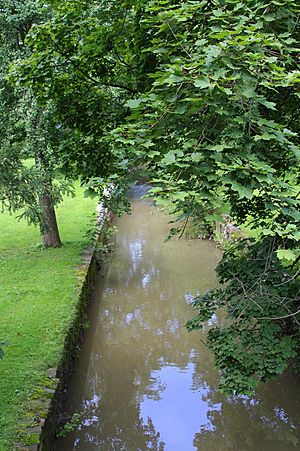Limestone Run (Union County, Pennsylvania) facts for kids
Limestone Run is a stream in Union County, Pennsylvania. It is also sometimes called Bull Run. This stream is about 5.8 miles (9.3 kilometers) long. It flows into the West Branch Susquehanna River. Limestone Run passes through East Buffalo Township, Buffalo Township, and the town of Lewisburg. A man named Ludwig Derr once built a mill on this stream a long time ago. Limestone Run has one main named smaller stream that flows into it, called Miller Run.
Contents
Where does Limestone Run flow?
Limestone Run actually starts underground! It begins where East Buffalo Township and Buffalo Township meet, near a place called Lochiel.
The stream first flows northeast for a short distance, crossing Pennsylvania Route 45. Then, it turns west and follows Pennsylvania Route 45 for several miles. It takes another turn, heading southeast briefly and crossing Pennsylvania Route 45 again. After that, it turns northeast and crosses the state route one more time.
Limestone Run then enters the town of Lewisburg. Here, it turns southeast, crossing U.S. Route 15 and Pennsylvania Route 45. Finally, the stream flows into the West Branch Susquehanna River in southeastern Lewisburg, close to Bucknell University.
Smaller Streams Joining Limestone Run
Limestone Run has six smaller streams, called tributaries, that flow into it. Only one of these, Miller Run, has an official name.
What's in the water?
Scientists often study the water in streams like Limestone Run to see how healthy they are.
The amount of oxygen dissolved in the water of Limestone Run and its smaller streams can change. This oxygen is important for fish and other water creatures to breathe. The water's pH level, which tells us if the water is acidic or basic, is usually between 7.17 and 7.88. This is a good range for most aquatic life.
In 2003, the water temperature was measured. It ranged from about 59.9 degrees Fahrenheit (15.5 degrees Celsius) to 68.3 degrees Fahrenheit (20.2 degrees Celsius). The water also has a certain amount of alkalinity, which helps keep the pH stable.
The water's conductivity shows how well electricity can pass through it. This tells scientists about the amount of dissolved salts and other materials in the water. The turbidity of the water tells us how cloudy or clear it is. Sometimes, the water can be quite cloudy, especially in Lewisburg.
Scientists also look at the amount of total dissolved solids (TDS) in the water. These are tiny bits of minerals, salts, and other substances that are dissolved in the water. The amount of TDS can change along the stream.
Nitrates and Other Chemicals
The water in Limestone Run has relatively high levels of nitrates. This is because the stream flows through a lot of farmland. Fertilizers used on farms can wash into the stream, increasing nitrate levels.
Luckily, there are almost no phosphates in Limestone Run, except right near where it starts.
Other chemicals found in the water include chlorides (like salt), sulfates, sodium, magnesium, aluminum, potassium, and calcium. There are also tiny amounts of manganese, iron, copper, zinc, cadmium, and lead. Some of these are so low they are hard to detect.
Because of some of these findings, parts of Limestone Run are considered "impaired" by the Pennsylvania Department of Environmental Protection. This means the water quality isn't as good as it should be for all uses.
What kind of rocks are around the stream?
The land around Limestone Run is made up of different types of rocks. Much of the southern part of the area has rocks from the Silurian period, which are mostly shale that contains calcium. Other parts have shale from the Bloomsburg and Mifflintown formations.
In the northern, central, and far southern parts of the area, you can find limestone rocks from the Devonian and Silurian periods. The Buffalo Valley is also located in the area that Limestone Run drains.
What area does the stream collect water from?
The area that Limestone Run collects water from is called its watershed. Much of the western part of this watershed is used for farming. Large sections in the middle and southeast are covered by forests. Most of the eastern part of the watershed has hard surfaces, like roads and buildings. The towns of Lewisburg and Linntown are both located within this watershed.
Limestone Run collects water from about two-thirds of the entire area of Lewisburg.
History of Limestone Run
Limestone Run has had a few different names over the years, including Spring Run, Wilson Run, and Bull Run.
In the 1700s, Ludwig Derr built a mill right on the stream. This mill was still standing in 1860. Later, in 1785, David Kenedy bought a large piece of land (200 acres) along Limestone Run.
In the early 1900s, some people in Lewisburg used to put their waste water into Limestone Run. This was before modern sewage systems were common.
Limestone Run has flooded five times between 1997 and 2012. After the floods in 2012, workers helped by stabilizing the banks of Limestone Run and changing the stream's path a bit to help prevent future flooding.
What lives in and around the stream?
Scientists have found E. coli bacteria in the waters of Limestone Run and its tributaries. These bacteria can come from animal waste. Areas with more E. coli also tend to have a lot of algae growing.
In the upper and middle parts of the stream, farm animals like livestock can sometimes get into the water. You might also spot birds like Canada geese and wood ducks on the stream, especially upstream of Lewisburg.


